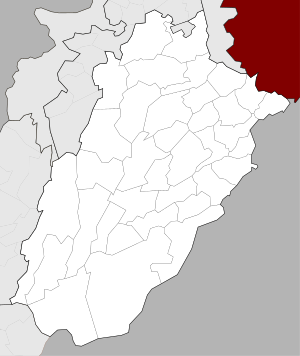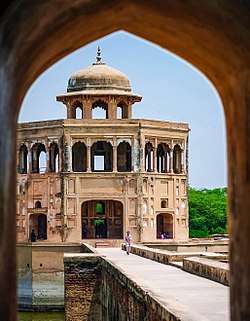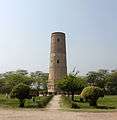Hiran Minar
| ہرن مینار | |
 Hiran Minar complex | |
 Location in Punjab, Pakistan  Hiran Minar (Pakistan) | |
| Coordinates | 31°44′35″N 73°57′18.7″E / 31.74306°N 73.955194°ECoordinates: 31°44′35″N 73°57′18.7″E / 31.74306°N 73.955194°E |
|---|---|
| Location | Sheikhupura, Punjab, Pakistan |
| Beginning date | 1607 |
| Completion date | 1620[1] |
| Website | |
Hiran Minar (Urdu: ہرن مینار; or "The Deer Tower") is an early 17th-century Mughal era complex located in Sheikhupura, in the Pakistani province of Punjab.
The complex was built at the site of a game reserve in honour of Mughal Emperor Jahangir's pet antelope. The Emperor is remembered for his fondness of nature,[2] and his complex embodies the Mughal relationship between humans, pets, and hunting.[3]
Location
The Hiran Minar complex is located in the city of Sheikhupura, about 40 kilometres northwest of Lahore. The complex is located near the Sheikhupura Fort, which also dates from the early 17th century. Both sites are accessible from Lahore via the M2 Motorway, which connects Lahore to the Islamabad.
History
Hiran Minar was built during the reign of the Mughal Emperor Jahangir in a hunting reserve used by the Mughal royals. The reserve was built in a scrub forest, and allowed Mughal emperors to experience a sense of semi-wilderness near the imperial city of Lahore.[4] The game-reserve was used as a park where visitors could enjoy the sport of hunting.[4]
The minaret itself was built in 1606 C.E. as a monument to Emperor Jahangir's beloved pet antelope, Mansiraj, or "Light of the Mind",[5] who had been trained to lure wild animals to the tank in order to be hunted.[3] The practice of building such tomb-markers over the skulls of game animals is an ancient Persian custom.[6]
The minaret and tank were soon accompanied by a larger pavilion, built during the reign of Shah Jahan.
Layout
The complex consists of a Jahangir-era minaret situated next to a larger Shah Jahan-era complex.
Minaret
The Jahangir-era minaret stands 30 metres tall,[4] and was built in 1606 C.E. as a tomb marker for the emperor's pet antelope,[4] Minraj. The sides of the minar are inscribed with a eulogy to the pet antelope.[4]
Pool
A massive rectangular water-tank pool measuring 229 metres by 273 metres lies at the heart of the complex.[4] At the center of each side of the tank, a brick ramp slopes down to the water, providing access for wild game that were sought by hunters.[7]
Pavilion

An octagonal pavilion built during the reign of Shah Jahan is at the centre of the pool.[7] The pavilion is two-storeyed, and is topped by a rooftop chhatri that served as a stone gazebo. The pavilion's architecture is similar to the Sher Mandal at Delhi's Purana Qila,[8] built by Emperor Humayun.
The pavilion was surrounded not only by the water tank, but also semi-wilderness. The pavilion was thus likely used for recreational purposes.[6]
Causeway
A causeway spans the pool to connect the minaret with the pavilion along an axis which passes through a gateway.
Hydraulics
Unique features of this particular complex are the antelope's grave and the distinctive water collection system. At each corner of the tank (approximately 750 by 895 feet (273 m) in size), is a small, square building and a subsurface water collection system which supplied the water tank; only one of these water systems is only extensively exposed today.[9]
Gallery


 The minaret which serves as a tomb marker for Emperor Jahangir's pet antelope.
The minaret which serves as a tomb marker for Emperor Jahangir's pet antelope. Hiran Minar, Water Tank, Pavilion
Hiran Minar, Water Tank, Pavilion Mughal Patterns inside Hiran minar
Mughal Patterns inside Hiran minar The Hiran Minar: Water Tank, Pavilion and Main Entrance
The Hiran Minar: Water Tank, Pavilion and Main Entrance

References
- ↑ Occasional Papers. The Gallery. p. 12. Retrieved 29 April 2017.
- ↑ Lari, Yasmeen (2003). Lahore: Illustrated City Guide. Heritage Foundation Pakistan. ISBN 9789698655013.
- 1 2 Brown, Rebecca (2015). A Companion to Asian Art and Architecture. John Wiley & Sons. ISBN 9781119019534. Retrieved 20 May 2017.
- 1 2 3 4 5 6 Ruggles, D. Fairchild (2011). Islamic Gardens and Landscapes. University of Pennsylvania. ISBN 9780812207286.
- ↑ http://www.gardenvisit.com/gardens/hiran_minar-deer_tower, 'Hiran Minar (Deer Tower)' with a satellite map on gardenvisit.com website, Retrieved 28 February 2017
- 1 2 Hillenbrand, Robert (2004). Islamic Architecture: Form, Function, and Meaning. Columbia University Press. p. 160. ISBN 9780231101332. Retrieved 20 May 2017.
- 1 2 http://whc.unesco.org/en/tentativelists/1281/, 'Hiran Minar and Tank, Sheikhupura' on unesco.org website, Retrieved 28 February 2017
- ↑ Sprenger, Aloys (1997). Austrian scholarship in Pakistan: a symposium dedicated to the memory of Aloys Sprenger. p. 107. Retrieved 20 May 2017.
- ↑ https://www.youtube.com/watch?v=GUQpSWjCQ-8, A short documentary videoclip on Hiran Minar on YouTube, Retrieved 28 February 2017
External links
| Wikimedia Commons has media related to Hiran Minar. |